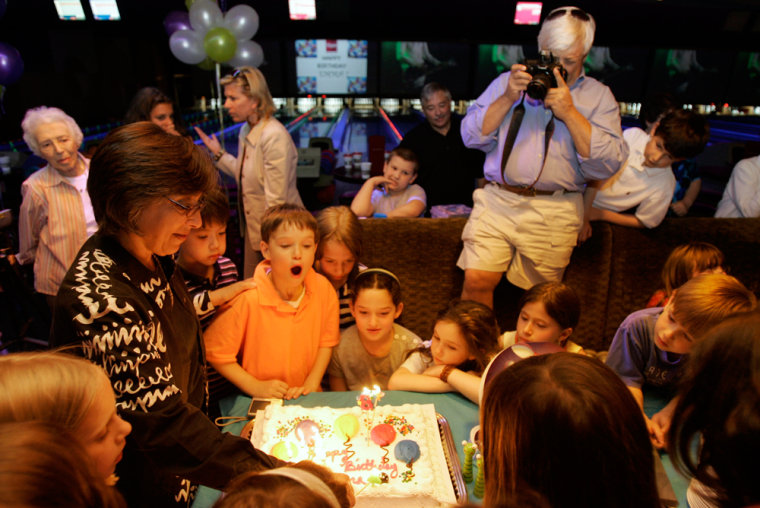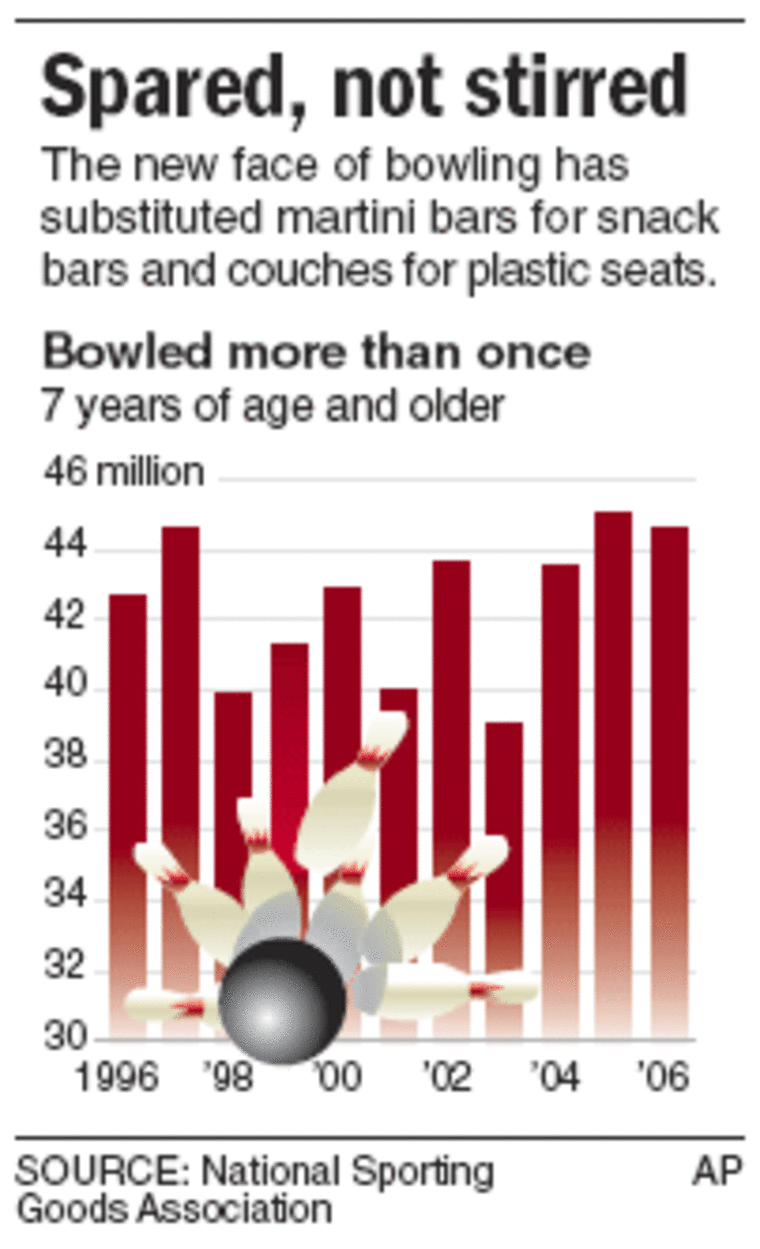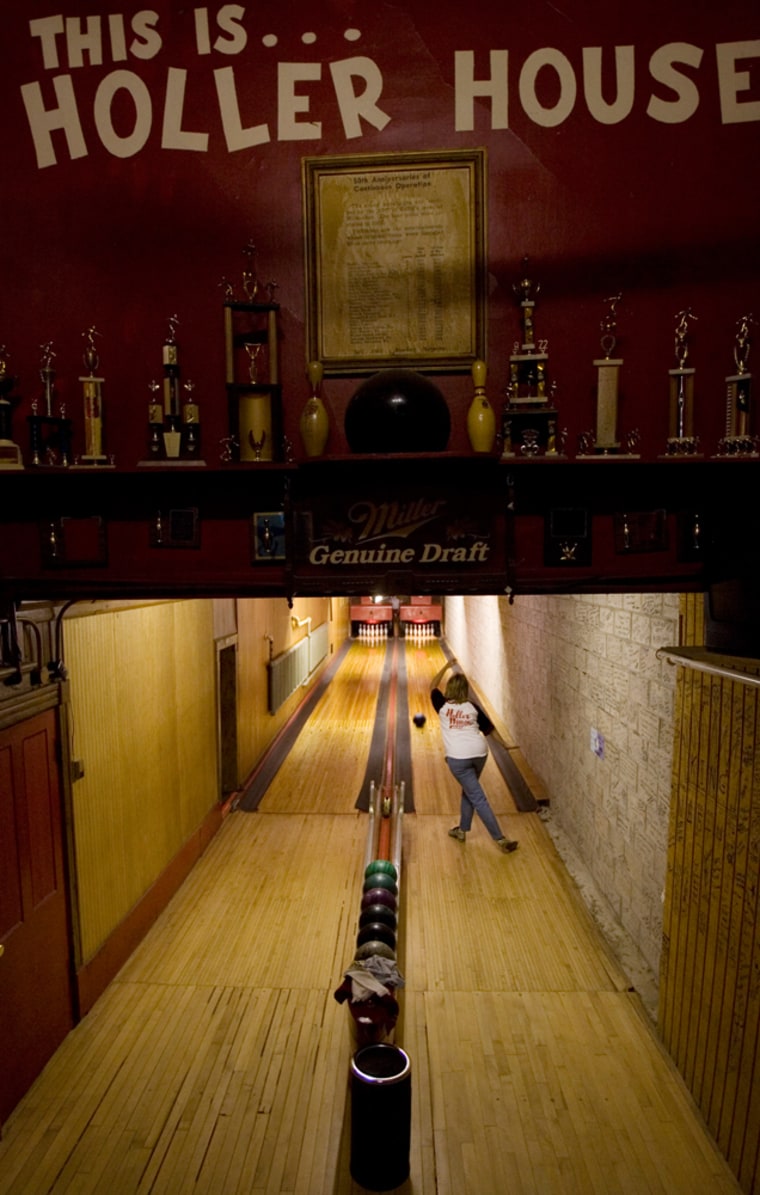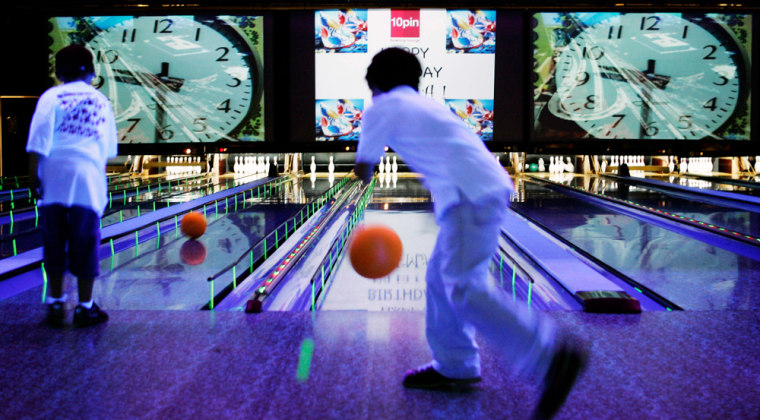The music is loud and pulsating, the air oozes with hipness. The bar is packed with stylishly dressed young professionals drinking martinis and surveying the scene.
Take away their ugly three-toned shoes and the 24 spit-polished lanes and this would be just another trendy joint.
After two decades of decline, bowling is rolling with a polished new look.
Laverne and Shirley, cigarette smoke choking the air, and bad polyester shirts — that’s so 1980.
The number of traditional alleys and weekly bowlers may be dropping, but “bowling centers” have made the sport more popular than ever and are generating some serious cash.
What once was mostly a patchwork of mom-and-pop operations has ballooned into a $10 billion industry.
“It’s definitely attracting a different market than it used to,” said Grant DePorter, president of Harry Caray’s Restaurant Group, which owns 10pin, an upscale bowling center in downtown Chicago. “The atmosphere is a giant paradigm shift. It’s not their father’s bowling alley.”
And in what might be the ultimate seal of approval, there’s even bowling with the stars.
Chris Paul, the NBA rookie of the year last year, recently signed on as spokesman for the U.S. Bowling Congress. LeBron James not only has his own ball, he’s putting a couple of lanes in the swanky new house he’s building.

“We’re optimistic in the fact we’re putting in place a lot of programs that are going to turn it around eventually. But we know it’s going to take some time,” said Mark Miller of the USBC.
“It’s in the next five, 10 years that it’s going to take off,” Miller added. “It took 20-something years to get to this point, it’s going to take some time to get back.”
There were about nine million regular bowlers — those who bowl once a week — in 1979-80. Now, there are only 2.7 million, according to USBC figures.
“If you go back 15, 20 years, league play would account for 70 percent of revenues. These days, league play is well under 50 percent,” said Sandy Hansell, a financial adviser who sells and appraises bowling centers.
Sport reflects change in society
“It used to be a lot of bowling leagues were built around organizations and companies: the Elks Club, Kiwanis Club, the sisterhood of your church or temple. A lot of that has gone by the wayside. People spent their whole careers with one company, now they don’t,” Hansell said. “All these societal factors have shrunk the number of people who are willing to bowl in traditional leagues. So the bowling proprietors have had to react.”

When Mark Iverson bought the Diversey River Bowl in Chicago in 1986, the alley was a microcosm of what was wrong with bowling: The building was rundown, the machines and lanes were outdated and there was little else to entice people to visit.
Iverson upgraded the lanes, installed disco-esque light shows and mounted monster speakers to give the place a throbbing beat.
The regulars weren’t too crazy about the facelift, but others were.
“The younger people came out and said, ‘Oh wow, cool.’ That’s how we got to be known as the Diversey Rock ’N Bowl,” Iverson said. “That’s how we got the young people in.”
Soon, alleys across the country were restyling themselves as entertainment centers.
There are 5,500 bowling alleys in the United States now, half the number that existed in the 1960s. But many of the new ones are gigantic — a quarter have 32 lanes or more — and offer as much to do as an amusement park. Flat-screen TVs, rock-climbing walls and laser tag are just some of the added attractions.
24/7 bowling and all the necessities
In Las Vegas, Red Rock Lanes at the Red Rock Casino has 72 lanes open 24 hours a day, seven days a week. There’s a video wall of projection screens hanging above the end of the lanes, and those who don’t want to bowl can check out the pool tables, shuffle board or darts.
A wait staff serves food and drinks; there are VIP lanes for private parties.
“That smoke-filled, beer-swilling, potbellied bowler? That image is long gone,” said Hansell, the financial adviser.
In many parts of the country, refurbished centers are making bowling more of a base rather than the main attraction. The lone Pac-Man machine has been replaced by a full video arcade, the bar was expanded into a lounge — complete with karaoke. Frozen pizzas were replaced by full menus.
After years of catering to regulars, the industry began focusing on the casual bowler and families. Lane bumpers and smaller balls were introduced to make the game more kid-friendly, and enough neon was splashed around to keep places aglow.
“It is coming back,” said Melinda Metzger, whose daughter, Emma, had her 8th birthday party at 10pin. “For a while, bowling was really down and out. Now, if it’s a rainy day, we’ll say, ‘Let’s go to the bowling alley.”’
That doesn’t mean those old-time alleys have disappeared.
Oldest bowling built nearly a century ago
The USBC’s Miller estimates that about a third of all bowling centers are still small operations, with the oldest being the Holler House on the south side of Milwaukee.

Two old-school lanes are tucked away in the basement, and look virtually the same way they did when the place opened in 1908. The wood is original, and a pin boy still tends the lanes. Scoring is done on white sheets of paper that hang on the walls on either side of the lanes.
“They used to bowl by gaslight down here,” owner Marcy Skowronski said. “Those guys, smoking their big cigars, I’m surprised they didn’t blow themselves up.”
Upstairs, a sign advertises mixed drinks for 15 cents and there’s an icebox behind the bar. The tin ceiling is covered with bras left behind by first-time visitors, a tradition dating back some 40 years.
“You can’t get bored in this place,” Skowronski said.
Still, she doesn’t begrudge the industry’s makeover.
“They’ve got to do something to get people in,” she said.
Though the days of league play and the numbers of regular bowlers are dwindling, industry officials are determined to rebuild the sport itself.
The PBA Tour is televised on ESPN, drawing about 1 million viewers despite going up against football and basketball. High school bowling has taken off, and now there are 18 states where it’s a varsity sport, triple the number from 10 years ago.
“I hope other people will start to enjoy it and understand that it is a sport. It’s tough,” said Paul, who got hooked on bowling as a kid when he and his brother tagged along with their father.
“You can go with a lot of friends and have it be a social event. Or you can go with people who bowl a lot and be competitive.”
At his “Chris Paul Winston-Salem Weekend” charity fundraiser last year, the highlight was the celebrity bowling tournament, which drew an All-Star crowd with James, Wade and Carmelo Anthony.
The event was such a rousing success, invites for this year’s event in September are already in demand.
